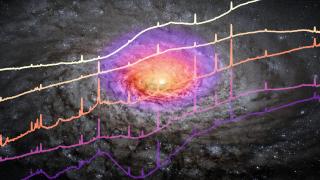Bibcode
Speranza, G.; Balmaverde, B.; Capetti, A.; Massaro, F.; Tremblay, G.; Marconi, A.; Venturi, G.; Chiaberge, M.; Baldi, R. D.; Baum, S.; Grandi, P.; Meyer, E. T.; O'Dea, C.; Sparks, W.; Terrazas, B. A.; Torresi, E.
Bibliographical reference
Astronomy and Astrophysics
Advertised on:
9
2021
Journal
Citations
24
Refereed citations
23
Description
We analyze VLT/MUSE observations of 37 radio galaxies from the Third Cambridge catalogue (3C) with redshift < 0.3 searching for nuclear outflows of ionized gas. These observations are part of the MURALES project (a MUse RAdio Loud Emission line Snapshot survey), whose main goal is to explore the feedback process in the most powerful radio-loud AGN. We applied a nonparametric analysis to the [O III] λ5007 emission line, whose asymmetries and high-velocity wings reveal signatures of outflows. We find evidence of nuclear outflows in 21 sources, with velocities between ∼400 and 1000 km s−1, outflowing masses of ∼105 − 107 M⊙, and a kinetic energy in the range ∼1053 − 1056 erg. In addition, evidence for extended outflows is found in the 2D gas velocity maps of 13 sources of the subclasses of high-excitation (HEG) and broad-line (BLO) radio galaxies, with sizes between 0.4 and 20 kpc. We estimate a mass outflow rate in the range 0.4-30 M⊙ yr−1 and an energy deposition rate of Ėkin ∼ 1042 − 1045 erg s−1. Comparing the jet power, the nuclear luminosity of the active galactic nucleus, and the outflow kinetic energy rate, we find that outflows of HEGs and BLOs are likely radiatively powered, while jets likely only play a dominant role in galaxies with low excitation. The low loading factors we measured suggest that these outflows are driven by momentum and not by energy. Based on the gas masses, velocities, and energetics involved, we conclude that the observed ionized outflows have a limited effect on the gas content or the star formation in the host. In order to obtain a complete view of the feedback process, observations exploring the complex multiphase structure of outflows are required.
Related projects

Nuclear Activity in Galaxies: a 3D Perspective from the Nucleus to the Outskirts
This project consists of two main research lines. First, the study of quasar-driven outflows in luminous and nearby obscured active galactic nuclei (AGN) and the impact that they have on their massive host galaxies (AGN feedback). To do so, we have been granted time with the Gran Telescopio CANARIAS (GTC) in the optical and near-infrared ranges
Cristina
Ramos Almeida